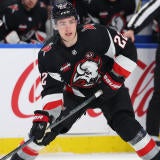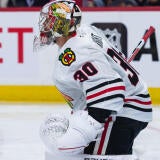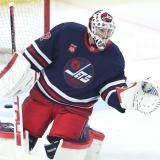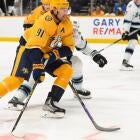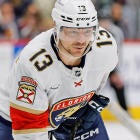
2014 Draft Prep: Busts for Draft Day
Not every player is created equally. That also goes for expectations placed upon them. Dan Pennucci examines those he thinks are lining up to disappoint Fantasy owners.
The players listed here fall into several categories of what can be considered a bust. Some players will regress back to the mean while others may end up falling well short of expectations in a new city. There are multiple ways to define a bust and injuries did not factor much into the process. For instance, last season Tobias Enstrom of Winnipeg ended up being a rather sizable bust. A player who had two consecutive 50-point seasons followed by injury-riddled productive campaigns in terms of points-per-game, Enstrom was woeful last year, playing in all 82 games and managing 30 points.
Busts, to this author, are a gross underachievement when compared to what a player regularly is expected to do when healthy or efforts well below an average performance.
Career-Year Busts
This section is reserved for players who had breakout and career seasons one year earlier and it's not an indictment against their ability to contribute regularly to your roster, but more of a signaling of their regression toward the mean. Think of it as a statistical overcorrection; it's not that the player is having a bad season, but that they're simply producing more in line with their career averages.
Joe Pavelski, C/W, Sharks: Pavelski rewarded owners handsomely last season with a 41-goal campaign and 79 points. Pavelski likely will have a fine season somewhere around the 30-goal, 70-point mark, but expecting him to crack 40 goals again may be asking a bit much. His 18.2 shooting percentage was almost six points higher than his previous career-best and nine of his 41 goals came via three hat tricks, leaving a paltry 32 goals in the other 79 games. What a slacker. San Jose still has a potentially dangerous offense led by little Joe and Logan Couture, but Pavelski will go much higher than he should on the heels of last year's monster season, which landed him third in the league in goals and ninth in points. The shooting percentage is the outlier and the chief indicator that a regression back to the mean is coming. The good thing is that Pavelski's mean is better than most players' career-best seasons. Don't pay for last year's numbers expecting an encore, but he'll be more than capable of bagging 30 goals.
Alexander Steen, C, Blues: Steen has long been tantalizing owners with his potential and cries of "this is the year." The son of the former Winnipeg Jet broke out. While St. Louis enjoyed its best regular season in several years, the Blues received a boost from Steen and his 33-goal campaign. He posted 12 goals in 11 games to start the season, but it was Steen's finish that should have owners a bit concerned, as he posted just five goals after the Olympic break. Steen will be a trendy pick with St. Louis adding Paul Stastny and the potential of the Blues' younger players like Jaden Schwartz to continue their growth, but Steen had two average seasons after consecutive 20-goal campaigns in 2010 and 2011. During the 2013-14 season, Steen shot at a ridiculously high 15.6 clip, a rate that suffered late in the season as his shots-on-goal didn't decrease. Expecting Steen to duplicate last season's totals is lofty, as there is too much of a spike in those numbers with regards to his track record.
Plain Busts and Free Agent Busts
Antti Niemi, G, Sharks: Cracks began to show in Niemi's game toward the latter part of the 2014 campaign, as he lost some time to Alexander Stalock down the stretch, even sitting out the team's Game 6 loss to Los Angeles in their catastrophic opening-round exit. Niemi and the Sharks surrendered a 3-0 series lead to the eventual champions, with home ice to boot, resulting in questions arising surrounding Niemi's role this season. He had several spotty performances in the season's final two months after both he and the Sharks looked like clear Cup contenders in the early going. The 39 wins were nice, but the overall .913 save percentage was his lowest since becoming a full-time starter in 2011 and his 2.39 goals-against average left much to be desired by owners in rotisserie leagues. The fact that Stalock had better numbers in the games he started and was just inked to a two-year extension should mean a decrease in Niemi's playing time. Odds are Niemi will be given just enough of a leash before he sees his ice time diminshing.
Free Agent Busts
Jussi Jokinen, W, Panthers: Jokinen parlayed last season's Sidney Crosby-adjacent numbers into a free agent deal with Florida where his 57 points were 19 more than the Panthers' team leader, Nick Bjugstad. Jokinen becomes a driver on a team with two incredible young talents in Bjugstad and Jonathan Huberdeau, but one has to be wary of how Jokinen will handle the increase in minutes. He's a versatile player who can man both the center and the wing, as well as kill penalties, but last season's breakdown reveal some stretches of futility, including bagging just one goal from November 9 until December 31. Last season marked just the second time Jussi cracked 20 goals, as he potted 30 in 2009-10 for Carolina. He's been a supporting player for most of his career and he's joining one of the league's worst offensive teams where he will be a top-line player. Tread carefully, if at all.
Thomas Vanek, W, Wild: This one likely won't be a popular decision given the fanfare Vanek received heading back to the Twin Cities, the place he honed his craft as a Golden Gopher. Vanek joins a rising squad with the likes of talented veterans Zach Parise, Mikko Koivu and Jason Pominville. Those who have owned the utterly talented Vanek in the past will know how maddeningly inconsistent he is vis-a-vis his skill level. Vanek played at close to a point-per-game on all three of his teams last season (Buffalo, the Islanders and Montreal) and he'll turn 31 in January. He can binge on points but then disappear for stretches of time and Habs fans will be quick to remind all that Vanek managed just two assists in the team's Eastern Conference Finals loss to the Rangers. When Vanek wants to, it seems he can be one of the league's most dominant players, but inconsistency has plagued him. He'll go earlier than he should in most drafts, let others roll the dice on the Wild's No. 2 left wing.
Mike Cammalleri, W, Devils: Cammalleri was the centerpiece of New Jersey's free agent summer in their quest to assemble a team that would have been more competitive five years ago, coupled with last season's signings of Michael Ryder and Ryane Clowe. Cammalleri received a five-year contract with $5 million per-season as the Devils believe he can channel some of the skill not seen since his days in Los Angeles and early time with the Canadiens. The sniper had 26 goals for Calgary one season earlier scattered over 63 games due to stretches of injury and inconsistency. Despite the inconsistency, he posted his first season of more than 20 goals since the 2009-10 campaign, but he is joining a team and a coach, Peter DeBoer, that likes to shuffle around lines. Cammalleri should see some time with the likes of Jaromir Jagr and Patrik Elias, but the odds are more likely he will be flanked by Ryder, Clowe or Martin Havlat. Cammalleri will have every opportunity to crack 30 goals in New Jersey but the situation and team's inability to score will have a negative impact on his output.
Ryan Kesler, C, Ducks: As my RotoWire colleague Janet Eagleson says "Kesler is old for his age." Kesler joins Anaheim after all but calling up the Ducks himself and begging for a release from Vancouver. He gives the team the second line center they could have used last year in the playoffs, but expecting him to do more than the 20-plus goals he's put up most seasons is not wise. His style of play causes him to see a bit more physical contact as well as play while injured, as he has missed just 10 total games in each of the last two 82-game seasons. (He sat out 31 in 2013's truncated campaign). Kesler is a solid-all around center, but he won't produce near the level of where he'll likely be drafted.
Matt Niskanen, D, Capitals: Niskanen was the beneficiary of injuries to Kris Letang and Paul Martin last season, as the throw-in in the James Neal-Alex Goligoski trade bagged a career-best 46 points, hitting double-digit goals for the first time in his career. Niskanen now heads to a revamped Washington team where he will compete for power-play time alongside the player who used to be Mike Green and rising talent John Carlson. The 27-year old Niskanen signed a seven-year contract worth just over $40 million and figures to see plenty of top-four minutes but may struggle duplicate last season's numbers, as 15 of his 46 points came on the power play and his average ice time jumped several minutes from his first few seasons in Pittsburgh. The increased minutes led him to notch a career-best in shots on goal, 162, by over 40, as he averaged two shots-on-goal. Niskanen registered 35 points his second season in the league at just 21 years old and he's been battling to get back there since. Last season's numbers were a direct result of his increased ice time due to the time missed by the Penguins' top two defensemen. However, it is worth noting that offensive-minded defenders in Barry Trotz's system can be productive. Caveat Emptor.
Christian Ehrhoff, D, Penguins: A recipient of one of the largest compliance buyouts, the Sabres were able to rid the albatross of Ehrhoff's 10-year, $40 million contract last summer, allowing the veteran to sign a one-year deal with Pittsburgh where he's certain to see some power play time. Ehrhoff notched three consecutive seasons of 40 points or more, hitting 50 in his last season with Vancouver in 2010-11. Since joining Buffalo in 2011, Ehrhoff has managed a modest 16 total goals after consecutive seasons of 14. His bloated contract and lack of productivity didn't fit with Buffalo's new direction, but he's unlikely to have offensive success in Pittsburgh. With a healthy Kris Letang, a healthy Paul Martin and a budding star in Olli Maatta, Ehrhoff will have to battle for power-play time, a power play that will flow through Letang, Sidney Crosby and Evgeni Malkin. Ehrhoff simply isn't shooting as much as he did earlier in his career and likely won't see a spike in the numbers he grabbed in Buffalo.
Ryan Miller, G, Cauncks: Miller's time in Vancouver this season could bear strong resemblance to his time in Buffalo before his deadline deal to St. Louis. The Canucks are a team in full rebuild-mode with a patchwork defense and less-than-stellar offense. Miller signed on to guide the Canucks back to relevance in one of the league's toughest divisions and could be a risky play. True, he managed to put up decent numbers for Buffalo, but his brief tenure in St. Louis will be remembered for a lackluster finish to the regular season and the Blues' first-round exit at the hands of Chicago, where he surrendered 12 goals in the final three losses of the series. Miller played well in March following his arrival in St. Louis, but a goals-against average of 3.11 coupled with a .885 save percentage in six April games did not help St. Louis much, especially after he did everything possible to keep Buffalo in some games earlier in the season. How Miller will fare in Vancouver is a vexing question, but it may not all be his fault given the surrounding cast. Expect a few otherworldly stretches from Miller, but overall a lack of consistent goaltending when compared to the contract he signed with Vancouver.
Jonas Hiller, G, Flames: Few goaltenders are going to have as much leeway in a new city as Hiller will in Calgary. There isn't a clear challenger to the crease in southern Alberta and Hiller will be eager to see No. 1 minutes after injuries and young usurpers chased him away from Anaheim. Hiller joins a young team in a rebuild that has some talent, including one of the league's most underrated defenders in Mark Giordano. Hiller is 32 and coming off of several mediocre seasons considering how well Anaheim played over that stretch. He's worth a look after the established netminders are snagged, but do you want to hitch your roster's wagon to Calgary? In that division?
ADP Busts
The players listed here are all talented. Most will have solid seasons, but most will go several rounds or more higher than they should in most drafts. They'll put up steady numbers, but not numbers worth where they will be picked simply because of their name and the fact that they are present in the mind of hockey fans for one reason or another.
Jonathan Quick, G, Kings: The Kings' netminder recently captured his second Stanley Cup and is on his way to padding his resume for the Hall of Fame in more than a decade's time. Quick and the Kings struggled a bit earlier in the season before he missed over a month with a groin injury but he finished strongly despite not being terribly great at times in the playoffs (see Western Conference Finals vs. Chicago). While a full season from Quick could see him challenge 35-40 wins, he'll go earlier than he should in most drafts. He's a big name and definitely a solid netminder, but he can be streaky at times and the Kings certainly were a streaky team even while Quick was healthy. If you're a fan of track records, the season following the Kings' first Stanley Cup win in 2013 saw Quick have a spotty season with a 2.45 goals-against average. Let someone else bite earlier on the big name.
Rick Nash, W, Rangers: Nash famously disappeared in the postseason, potting only three goals in the Rangers' run to the Stanley Cup Final and failing to register a point in the five games against Los Angeles. Nash will always be given a pass due to his talent, draft status and the general notion that he has another gear and it's a matter of time before the Brampton native unleashes it. After two seasons in New York, Nash has 47 goals through 109 games, but most expect more. Most will continue to expect more and reach for Nash earlier than they should. Last season was one of the lowest point-per-game rates in his career and his invisibility in the playoffs was widely noted. If he finishes with 30 goals and 60 points, that's still a solid season for most players, yet, Nash will go at least three or four rounds higher than he should simply because of his name.
Duncan Keith, D, Blackhawks: Easily one of the top three all-around defensemen in the league, Keith had his best season in several years with an assist-heavy 61 points, his highest total since he won the Norris in 2010. Keith is one of the most recognizable defenders in the NHL and will probably put up consistent numbers in the 45-50 point range with a ton of assists. There are plenty of other goal-scoring defenders who should go before Keith but won't because of name recognition. Keith finishing with 45-50 points will still be a strong season, but the assist-heavy numbers will be worth less with regards to where he will be drafted.
*You should also add Ryan Suter and Drew Doughty to the list of uber-talented defenders whose statistics won't match their draft slot. They'll be consistent, but their stock is inflated because of their name.
T. J. Oshie, RW, Blues: Easily the newest member to the collective casual hockey fan consciousness, Oshie's shootout performance in Team USA's preliminary win over Russia was an amazing display of individual ability and stickhandling. That was also coupled with a career-best 60-point season, a season that was riddled with some inconsistency. In 22 games following the Olympic break, Oshie snagged 14 points; nine of those points came in three separate three-point efforts leaving five for the other 19 games, including a barren stretch of six pointless games at season's end. Oshie is a recognizable name who has cracked 20 goals just once in his career. He'll likely have a solid season for St. Louis, but his name will cause him to be called much earlier than it should on Draft Day. Let others gamble on him.
Also consider: Zach Parise, (LW, Minnesota), the Sedins (Vancouver), Justin Schultz (D, Edmonton), Milan Lucic (LW, Boston), Patrice Bergeron (C, Boston), Brad Marchand (W, Boston), Jeff Carter (C, Los Angeles), Dion Phaneuf (D, Toronto).



